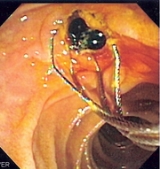
Endoscopic retrograde cholangiopancreatography
Overview
Endoscopy
Endoscopy means looking inside and typically refers to looking inside the body for medical reasons using an endoscope , an instrument used to examine the interior of a hollow organ or cavity of the body. Unlike most other medical imaging devices, endoscopes are inserted directly into the organ...
and fluoroscopy
Fluoroscopy
Fluoroscopy is an imaging technique commonly used by physicians to obtain real-time moving images of the internal structures of a patient through the use of a fluoroscope. In its simplest form, a fluoroscope consists of an X-ray source and fluorescent screen between which a patient is placed...
to diagnose and treat certain problems of the biliary
Bile duct
A bile duct is any of a number of long tube-like structures that carry bile.Bile, required for the digestion of food, is excreted by the liver into passages that carry bile toward the hepatic duct, which joins with the cystic duct to form the common bile duct, which opens into the intestine.The...
or pancreatic duct
Pancreatic duct
The pancreatic duct, or duct of Wirsung , is a duct joining the pancreas to the common bile duct to supply pancreatic juices which aid in digestion provided by the "exocrine pancreas"...
al systems. Through the endoscope, the physician can see the inside of the stomach
Stomach
The stomach is a muscular, hollow, dilated part of the alimentary canal which functions as an important organ of the digestive tract in some animals, including vertebrates, echinoderms, insects , and molluscs. It is involved in the second phase of digestion, following mastication .The stomach is...
and duodenum
Duodenum
The duodenum is the first section of the small intestine in most higher vertebrates, including mammals, reptiles, and birds. In fish, the divisions of the small intestine are not as clear and the terms anterior intestine or proximal intestine may be used instead of duodenum...
, and inject dyes into the ducts in the biliary tree and pancreas
Pancreas
The pancreas is a gland organ in the digestive and endocrine system of vertebrates. It is both an endocrine gland producing several important hormones, including insulin, glucagon, and somatostatin, as well as a digestive organ, secreting pancreatic juice containing digestive enzymes that assist...
so they can be seen on X-rays.
ERCP is used primarily to diagnose and treat conditions of the bile ducts, including gallstones, inflammatory strictures (scars), leaks (from trauma and surgery), and cancer.
ERCP can be performed for diagnostic and therapeutic reasons, although the development of safer and relatively non-invasive investigations such as magnetic resonance cholangiopancreatography
Magnetic resonance cholangiopancreatography
Magnetic resonance cholangiopancreatography is a medical imaging technique that uses magnetic resonance imaging to visualise the biliary and pancreatic ducts in a non-invasive manner...
(MRCP) and endoscopic ultrasound
Endoscopic ultrasound
Endoscopic ultrasound or echo-endoscopy is a medical procedure in endoscopy is combined with ultrasound to obtain images of the internal organs in the chest and abdomen. It can be used to visualize the wall of these organs, or to look at adjacent structures...
has meant that ERCP is now rarely performed without therapeutic intent.
- Obstructive jaundice - This may be due to several causes
- Chronic pancreatitisPancreatitisPancreatitis is inflammation of the pancreas. It occurs when pancreatic enzymes that digest food are activated in the pancreas instead of the small intestine. It may be acute – beginning suddenly and lasting a few days, or chronic – occurring over many years...
- a now controversial indication due to widespread availability of safer diagnostic modalities including endoscopic ultrasoundEndoscopic ultrasoundEndoscopic ultrasound or echo-endoscopy is a medical procedure in endoscopy is combined with ultrasound to obtain images of the internal organs in the chest and abdomen. It can be used to visualize the wall of these organs, or to look at adjacent structures...
, high-resolution CT, and MRI/MRCPMagnetic resonance cholangiopancreatographyMagnetic resonance cholangiopancreatography is a medical imaging technique that uses magnetic resonance imaging to visualise the biliary and pancreatic ducts in a non-invasive manner... - Gallstones with dilated bile ducts on ultrasonography
- Bile duct tumors
- Suspected injury to bile ducts either as a result of trauma or iatrogenic
- Sphincter of Oddi dysfunctionSphincter of OddiThe sphincter of ampulla or sphincter of Oddi is a muscular valve that controls the flow of digestive juices through the ampulla of Vater into the second part of the duodenum. It is named after Ruggero Oddi...
- Pancreatic tumorsPancreatic cancerPancreatic cancer refers to a malignant neoplasm of the pancreas. The most common type of pancreatic cancer, accounting for 95% of these tumors is adenocarcinoma, which arises within the exocrine component of the pancreas. A minority arises from the islet cells and is classified as a...
no longer represent a valid diagnostic indication for ERCP unless they cause bile duct obstruction and jaundice.

